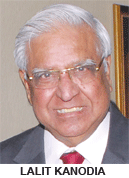Towards world-class IITs and IIMs
 Dr. Lalit Kanodia is the IIT-Bombay and MIT, USA-educated founder-chairman of the Datamatics Group
Dr. Lalit Kanodia is the IIT-Bombay and MIT, USA-educated founder-chairman of the Datamatics Group
It is the dream of most students in India to get admission into the country’s seven Indian Institutes of Technology (IITs) with nine in the offing, and 11 Indian Institutes of Management (IIMs) with two in the pipeline. Every year, over 750,000 school-leavers and graduates write the joint entrance exams of the IITs and IIMs, of whom only the top 98 percentile — 12,000 students — are admitted. This annual rush is understandable because IIT degrees or IIM diplomas are passports to excellent career pathways and economic prosperity.
But although India’s IITs/IIMs have huge domestic reputations and offer globally benchmarked education, they are not in the same league as the world’s best higher education institutions. IIT Bombay (187) was the sole ‘university’ ranked among the top 200 global institutions in the QS World University Rankings of 2010. Worse, while some IITs were included in the league tables of THE (Times Higher Education) until 2009, none are listed in the 2010 top 200 ranking or any of its sub-rankings, despite the faculty-student ratio at IITs/IIMs averaging 1:8-1:9, comparing well with Harvard (1:7) and MIT (1:8).
Therefore the question needs to be posed — and answered — why are the country’s showpiece IITs and IIMs which dominate the league tables of Indian business magazines and pink papers bottom-ranked also-rans in global league tables? One answer is their relative track records. MIT has produced 77 Nobel laureates who have either studied or taught at MIT, including four in economics. Columbia University has produced 112 Nobel laureates. Harvard Nobel winners aggregate 107; Oxford 51 and Cambridge 88. Moreover, eight US presidents were Harvard alumni, and 26 British prime ministers graduated from Oxford and 15 from Cambridge, including eight prime ministers and heads of state (Pandit Nehru and Lee Kuan Yew). Against this, not even one IIT/IIM has produced a Nobel laureate or head of state. Therefore it’s imperative to examine ways and means to nurture and improve our IITs/IIMs to bring them into the Top 10 league tables of international rating and ranking agencies such as QS, THE and the Financial Times. In my opinion, this requires:
Faculty activity focus. In the world’s best universities, faculty go beyond teaching into publishing, consulting, and research. This is particularly true of schools of engineering and management, where faculty and professors cannot impart up-to-date knowledge without engaging in all these four activities. Though the faculty of IITs/IIMs do engage in these activities, their primary focus is teaching. An IIM Review Committee (September 2008) report of the Union HRD ministry, strongly criticised their faculty stating “the quality and quantity of research papers from IIMs have not been commensurate with the status of IIMs and have not enabled IIMs to become thought leaders”.
Ph D intake. As most IIT/IIM review committees have stressed, these institutions need to sharply enhance their annual intake of Ph D students. This will not only create and construct new knowledge and case studies based on socio-economic conditions peculiar to India, but will also augment and improve the quality of faculty, bearing in mind that the great majority of Ph Ds tend to opt for teaching or research careers.
Faculty remuneration. The world over, faculty pay and perquisites don’t compare with corporate remuneration. Nevertheless the gap between IIT/IIM and corporate remuneration — although IIT/IIM salaries are 20 percent higher than the Indian university average — is too wide. Moreover, it’s pertinent to note that the professoriate abroad earns substantial supplementary income from consulting and short-term executive training programmes. Consequently, IITs/IIMs don’t attract the very best talent to sign up as faculty. If professors are encouraged to provide consultancy services and retain larger percentages of their earnings, it will substantially augment their incomes.
Faculty exchange programmes. Visiting faculty to institutions of higher education play the vitally important role of enriching and cross-fertilising institutional knowledge. This can apply to overseas faculty too. However, the quality of housing on IIT/IIM campuses will need upgradation, if we have to pursue this, particularly for overseas faculty.
Invite globally renowned faculty. In the newly emerging globalised world, the net for excellent faculty should be cast wide. Globally and nationally renowned scientists and professors should be heads of faculty, departments and laboratories, which can even be specifically promoted or encouraged for the purpose. For instance, Albert Einstein was invited to head the Institute of Advanced Study at Princeton University which added invaluable stature to Princeton. Likewise in 1972, TIFR (Tata Institute of Fundamental Research), Mumbai invited Prof. Jayant Narlikar from Cambridge University where he developed the famous Narlikar-Boyle theory and placed him in charge of TIFR’s theoretical astrophysics group. On the other hand, Prof. J.B.S. Haldane, a famous genetics and biochemistry scientist, who migrated from the UK to India in 1967, wasn’t given any important position in Indian academia. This pettiness and reluctance of Indian academia to appreciate genius explain why all four Indian Nobel laureates (post Dr CV Raman) viz. Hargobind Khorana, Amartya Sen and Subrahmanyan Chandrasekhar chose to live and work in the US.
Reservation of capacity. In all IITs/IIMs, almost 50 percent of capacity is reserved for scheduled castes (15 percent), scheduled tribes (7.5 percent), and OBCs (27 percent). Although minimum entry qualifying marks are lowered for students from these categories, reserved seats are seldom filled. Should we reserve (and waste) capacity in our premier institutions of education? There is a strong argument for exempting notified institutions — including medical colleges — from reservations. Please note there is no such reservation in the defence services.
Weeding out non-performers. In American academia, if an associate professor is not promoted to the office of professor within a stipulated period of time, he has no option but to resign. This automatically flushes out non-performers. It might be a good idea for the IITs/IIMs to examine this policy.
Government control. It’s hardly a national secret that in IITs/IIMs, the boards of directors are not adequately empowered and there is continuous government interference. Several review committees have recommended that responsibility for the management of the IITs/IIMs should be vested in their boards. This was reiterated by the Kakodkar Committee, recently constituted by the HRD ministry, in its report titled Recommendations to Take IITs Forward. Merely because the Central government funds the IITs/IIMs, it doesn’t follow that they should micro-manage them.
Introduce tenure. In American universities, it is standard practice for the professoriate to be divided into assistant professors, associate professors and professors. Almost all academics who make it to professor grade are awarded ‘tenure’, which means he/she remains professor for life, at full salary. Nobel laureate Prof. Paul Samuelson taught at MIT until he died at age 94, and Nobel laureate Prof. Robert Solow is employed at MIT at age 87. Tenure offers the best and brightest scholars and researchers a great incentive to enter academia and stay the course within them.
Funding. Currently, the country’s showpiece IITs/IIMs are funded by government grants and from government mandated (subsidised) student tuition fees, which leave hardly any surpluses with them despite the IIM Review Committee (2008) having recommended that “all IIMs which are over five years old should be able to generate a small operating profit”. More specifically, the Kakodkar committee too has recommended IIT tuition fees be raised from the heavily subsidised Rs.50,000 per year to at least Rs.2 lakh to cover revenue expenses.
Moreover, these institutes’ finances would be greatly boosted if they systematically solicited and raised funds and grants from alumni and philanthropists. Many of the alumni of these institutes have fared very well in business and industry and are ready and willing to donate handsomely to their alma maters. Annual incomes from endowment corpuses built over decades of organised fundraising activities by American universities are massive. For instance, Harvard University’s endowment corpus aggregates a stupendous $32 billion (Rs.160,000 crore), Yale $16 billion (Rs.81,600 crore), Princeton $13 billion (Rs.66,300 crore), Stanford $12 billion (Rs.61,200 crore), MIT $10 billion (Rs.51,000 crore). Against this, the endowment corpus (excluding sponsored research) of IIT-Bombay accumulated over 50 years aggregates a mere $3 million (Rs.16 crore). For the IITs/IIMs — indeed all higher education institutions — to replicate this experience, our tax laws need to be changed. Currently, for donors to qualify for an income tax deduction, all donations must be credited to an endowment fund managed and operated by the Central government which is the final arbiter of how donations can be deployed.
Establish donor schools and departments. In the US, major donors to education causes and institutions have universities named after them. Harvard, Stanford, Yale and Brown are global Top 10 universities named after great philanthropists. Other universities with constituent schools/departments named after them are the Sloan School of Management, Wharton School of Management, Kellogg School of Management, Stern School of Management. This tradition encourages donors to endow large grants and bequests which swell the endowment corpuses of universities across the US.
Switch to the per-student investment model. MIT has a budget of $2.5 billion (i.e. Rs.12,000 crore) per annum which it expends to meet the educational needs of 10,000 students. Hence, the expenditure per student at MIT is about $250,000 or Rs.1.2 crore. On the other hand, the per-student annual outlay of IIT-Bombay is a mere Rs.2 lakh. With this pathetic per student outlays, our showpiece IITs/IIMs are at a permanent disadvantage. Budgets can be increased if tuition fees are raised. The indiscriminate subsidies regime for all students needs to be urgently replaced with low-interest loans to IIT/IIM students liberally dispensed and guaranteed by the government. After graduation, their alumni receive handsome remuneration and can easily repay the loans.
As a former student of IIT-B and MIT, I can state with conviction that the energy levels and enthusiasm of students in American universities are way above those of their counterparts in India’s best colleges and universities. When I was conducting research at MIT, I used to visit the laboratory after dinner and stay up until well after midnight, almost every day. And it was routine for the lab to be crowded with students and faculty. Such energy levels are conspicuously absent in our IITs and IIMs.
All this is not to argue in favour of uncritical acceptance of Western academic values and norms. But surely, it’s not a crime to emulate their best practices. On the contrary, we need to shed exclusivism and import and adapt best practices of the world’s top-ranked universities to raise the profile of India’s showpiece IITs/IIMs.
Also read: IITs & IIMs control attempts






 Dr. Lalit Kanodia is the IIT-Bombay and MIT, USA-educated founder-chairman of the Datamatics Group
Dr. Lalit Kanodia is the IIT-Bombay and MIT, USA-educated founder-chairman of the Datamatics Group










Add comment